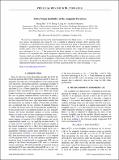Valley Stoner instability of the composite Fermi sea
Author(s)
Zhu, Zheng; Sheng, D. N.; Fu, Liang; Sodemann, Inti
DownloadPhysRevB.98.155104.pdf (676.0Kb)
PUBLISHER_POLICY
Publisher Policy
Article is made available in accordance with the publisher's policy and may be subject to US copyright law. Please refer to the publisher's site for terms of use.
Terms of use
Metadata
Show full item recordAbstract
We study two-component electrons in the lowest Landau level at total filling factor ν[subscript T] = 1/2 with anisotropic mass tensors and principal axes rotated by π/2 as realized in aluminum arsenide (AlAs) quantum wells. Combining exact diagonalization and the density matrix renormalization group we demonstrate that the system undergoes a quantum phase transition from a gapless state in which both flavors are equally populated to another gapless state in which all the electrons spontaneously polarize into a single flavor beyond a critical mass anisotropy of m[subscript x]/m[subscript y]∼7. We propose that this phase transition is a form of itinerant Stoner transition between a two-component and a single-component composite Fermi sea states and describe a set of trial wave functions which successfully capture the quantum numbers and shell filling effects in finite size systems as well as providing a physical picture for the energetics of these states. Our estimates indicate that the composite Fermi sea of AlAs is the analog of an itinerant Stoner magnet with a finite spontaneous valley polarization. We pinpoint experimental evidence indicating the presence of Stoner magnetism in the Jain states surrounding ν = 1/2.
Date issued
2018-10Department
Massachusetts Institute of Technology. Department of PhysicsJournal
Physical Review B
Publisher
American Physical Society
Citation
Zhu, Zheng et al. "Valley Stoner instability of the composite Fermi sea." Physical Review B 98, 15 (October 2018): 155104 © 2018 American Physical Society
Version: Final published version
ISSN
2469-9950
2469-9969